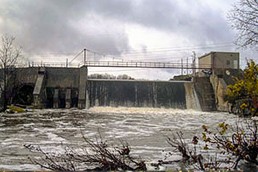SHARE THIS POST
With the recent issue of the permit from the U.S. Army Corps of Engineers, and the promise by the Ohio Chapter of the Sierra Club not to pursue legal action again this year, the demolition of the Ballville Dam in Fremont Ohio on the Sandusky River is expected to begin this fall.
The saga has dragged on for several years as people have challenged the removal of the 104-year-old, 407-foot-long structure due to concerns about flooding and loss of wetlands. But then came a leaking replacement reservoir, actions of elected city officials, the waiting of the results of a vote, and a lawsuit challenging sediment contamination levels.
While it was originally built to supply hydroelectric power, inadequate flows forced its use as a power-generating station to be abandoned. In 1959, the City of Fremont repurposed the dam to use it to impound the river to create an 89-acre lake for water supply purposes. After the last inspection, the dam was found to be in danger of failure and estimates to repair it were near $27 million, compared to under the $12 million required to remove it, mainly with state and federal funds.
To provide water supplies for the city, a new reservoir was built with local, state and federal funding and was stocked with fish. Due to the soil type in a portion of the reservoir, it had to be lined with clay—at significant, additional cost—raising city residents’ water rates.
At issue recently was the fear that the sediments behind the dam were contaminated or were so deep that they would smother the last remaining walleye-spawning sites downstream and raise nutrient levels in Lake Erie, just 10 miles downstream.
Are you enjoying this post?
You can be among the first to get the latest info on where to go, what to use and how to use it!
Retesting the sediment last year showed contamination levels no higher than the data showed in the earlier testing, which matched ambient river sediment levels. According to stream hydrologists, the volume of sediments loading is only expected to flow downstream at rates equal to what is currently observed after precipitation events. The fisheries biologists working for the Ohio Division of Wildlife have long maintained that the removal of the dam would improve the river’s health and allow access by fish to run upstream an additional 22 miles to Tiffin.
According to the Great Lakes Fishery Commission, fish species targeted for improvement include walleyes, white bass, six species of suckers, channel catfish, lake sturgeon, steelhead trout and other native and naturalized species. They also say that approximately 300 acres of suitable spawning habitat will become accessible, restore the sediment transport process, increase fish species diversity and provide better habitats with food for bald eagles and other animals.
The dam reportedly will also be lowered by notching the structure three separate times to gradually drain the impoundment behind the dam.
While speaking to the Outdoor Writers of Ohio, Ohio Division of Wildlife Chief Ray Petering proposed that former Ohio Fish Administrator Gary Isbell be allowed to have the first swing of the sledgehammer for his initial efforts to promote the removal of the dam. Petering also suggested Roger Knight, the retired DOW Lake Erie Fisheries Research Unit supervisor who now works on special projects with the Great Lakes Fishery Commission for his additional commitment to the project, follow the former administrator.
MWO
SHARE THIS POST
Did you enjoy this post?
You can be among the first to get the latest info on where to go, what to use and how to use it!
MWO
We believe being outdoors is good. With more than 1,000 articles each year, MidWest Outdoors magazine is all about sharing outdoor experiences with you—where to go, what to use and how to use it… whether you’re close to home or on that trip of a lifetime.


